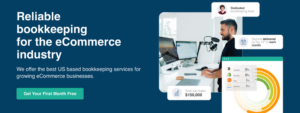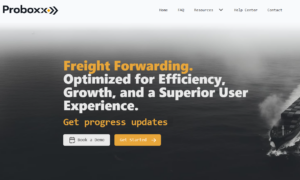We are Proboxx, a digital logistics provider who work with hundreds of Amazon sellers. In this article, we are going to go into details of understanding logistics.
Some are newbies, some intermediate, and some are 7 & 8 figure sellers.
What is common about almost all sellers is that their logistics and supply chain normally stay in a “grey area” where information is not transparent, and shipping procedures are unclear.
And as a result, the seller can find himself insecure with his current FF (freight forwarding company).

For understanding logistics procedure, we’re going to provide you with an in depth explanation about the general SOP for any of your shipments you manufacture in China or at any other destination.
For this instance we’ll refer to shipments delivery to US but the general SOP will be similar to any destination country.
Here is How it Goes: Understanding Logistics
Understanding Logistics #1: Your goods finish production or assembly at your supplier. They are put into cartons and shipping marks are printed on the outside. The outer carton is called a Master Carton or MC.
Understanding Logistics #2: If you decided to do a product inspection (which you should) Aa 3rd Party Inspection company that is hired by you, and is unaffiliated with your supplier or shipper, reviews your goods and confirms they are not defective. Then you pay your supplier.
Understanding Logistics #3: Your goods are transported from your supplier to the Port, or a warehouse near the Port. This is where LCL or FCL is important. If you are shipping a Full Container Load (FCL) the whole container is brought into the port directly. It sits there until the boat it is assigned to, arrives.
If it is Less Than a Container Load, (LCL) then your goods are brought to your FF’s warehouse near the port. It’s unloaded into the warehouse and sits there until the container it is assigned to is available.
Cut Off Dates
Each shipping line has its own cut off date which your freight forwarder is obligated to reach port cut off on time. Then it is loaded into the container. When the container is full, it is driven from the warehouse to the port where it sits until the boat it is assigned to, arrives.
When the boat arrives and is ready to be loaded, your container is lifted up by giant cranes and placed onboard.
This may take a few days.
Your goods and the container must go through exit Customs in China or at any origin and the manifest is reviewed.
This is the way that cargo is tracked across the globe. In China there are port fees, taxes, and export licenses to be reviewed. Luckily this is done on a computer and doesn’t delay departure. Yay for computers and the internet.
BOL
When the boat is full it leaves the dock and heads out on to water. At this point, with your stuff in a container, and the container on a boat, and the boat on the water, a legal document called a Bill Of Lading (BOL) is issued.
The BL is transferred to you, and it is your proof that 1) you own your good -Yay 😀 – and 2) it’s an official tracking record of your container number and your boat.
You can enter the container number into Track-Trace.com or at marinetraffic.com online and follow your boat across the ocean.
The Benefit of using the Proboxx Portal
If you use Proboxx, you will be able to track the vessel directly on your personalized Proboxx portal.
In your specific shipment, you will have a live map which will show you (using a red dot on the map) a live track of your vessel position.
If you have Fast Ship service, your boat will go directly to the port in the US.
And it may be on a newer quicker ship. If you have normal service your boat may stop at other ports and pick up more containers along the way. Don’t worry however, these days there is so much traffic that stops along the way rarely happens on ocean shipping from China.
Transit Times
In general the time to transport / transit time (port to port only!) to Long beach is 12-18 days, but their maybe delays if there is congestion like in 2021. The typical time from Shanghai / Ningbo / Yantian to Long Beach is 14-16 days.
In general the time to transport / transit time (port to port only!) is 32-35 days, but there may be delays if there is congestion in Panama canal. The typical time from Shanghai / Ningbo / Yantian to NY / NJ ports is 32-35 days.
If you do the math, each individual ship will travel from China to US (Long beach) and back again in about a month.
Hapag-Lloyd, Maersk, Cosco and others have thousands of ships, going from all the major ports in China every day. They usually have the same route between the same ports. In contrast, Matson (a small US based carrier that has two ships that travel between US and China) has one ship dedicated to a once a month run from Shanghai to US and back again.
Ooops, I think I just gave away a secret. All those FFs that charge you extra to be on one of the two Matson vessels that travel between China and USA may be lying. Your stuff is probably not on a Matson ship despite any extra money you paid.
Make sure your forwarder provides you with shipping data such as shipping line and container number so you will be able to track your shipments.
So… imagine your stuff is happily in a container
It goes across the ocean (tracked by satellite so you can follow it online) and when it gets 5 days away from reaching its destination port, (let’s say Long Beach in California) a Customs Broker in a office will alert US Customs and fill out a 7501 form. They will submit taxes on your products and click ‘submit.’ It takes less than a minute. As long as the documents match the manifest and CI, and Customs has no red flags about you, you are now done. Days before reaching port.
Congratulations. You have now passed Customs. 🙂 Yay for computers and the internet.
The taxes are called duties and the amount you pay is determined by your tariff amount (HTS) multiplied by the amount you paid your supplier as shown on your CI (Commercial Invoice.)
For DDP your forwarder pays the tariff. Be careful. If they don’t ask for your CI they are faking the amount of duties they are paying.
Finally, Your Vessel Arrives at Port
Your container is unloaded and is released from the port. This takes up to 4 days, no longer, according to US port regulations.

If you shipped LCL, your container is brought to your FF’s US warehouse and unloaded. This is called ‘devanning.’
Then, according to your arrangements, your goods are picked up and transported to the Amazon location, your own warehouse, or your home. Often UPS is used for this or are using LTL truck deliveries.
But…
Oh no! Sometimes your container is diverted for an examination. That occurs on less than
3 -4 % of all containers. So about 97% of containers do not get delayed for examination.
But don’t worry. Most of those examinations just take one day. The container is driven through a gigantic X-ray machine tunnel. (a side note, it can take few days depending on the congestion situation at the port for the container to move to the X ray site).
Or a CBP agent will open the back gate and peek inside. Very rarely, the container will be moved to a shed and opened and examined. Don’t worry. It’s very rare and there’s a lot of official notices, so it won’t happen much and you’ll always know.
That’s all there is to it.
It’s really quite easy and simple, but I want to clear up some myths and misconceptions
1) LCL and FCL have nothing to do with the terms of ownership, liability, and possession. Those are identified by Incoterms such as FOB, EXW, FAS, CIP, DDP, and 6 others.
2) Every one of the 11 Incoterms will result in you getting a Bill Of Lading so you can track your container. Except DDP. Every one of the 11 Incoterms will result with you receiving import documents so your accountant can make the right deductions on your taxes. Except DDP. Every one of those 11 Incoterms will indicate that you are the owner of your stuff. Except DDP.
Shipping DDP
For DDP, you do not get ownership (Despite paying the supplier) until your goods are delivered to Amazon, your warehouse, or your home.)
This makes it easy for the FF to pay the duties. But because you have zero visibility to any of the documents you have no idea what they actually declared as the value or quantity of goods.
They might lie about what’s in the container so they can pay less. This happens a lot, which is why you should be cautious if a FF gives you a DDP price without asking for your CI first.
And without a CI showing value, you can be sure that they are lying when they say your goods are insured.
Another concern with DDP is that without an official Bill Of Lading you don’t know know for sure which container your goods are in. Or which boat. It’s very common for shady FFs to claim your goods are one boat but really place them on a cheaper boat leaving many days later. There’s no way you really know.
Rest assured at Proboxx even if terms are DDP based – you will receive a BOL upon vessel departed at origin so you can sleep well and be sure you have full transparency and you will know your cargo position at any moment.
Customs
Earlier I said that Customs takes less than a minute and is done 5 days before the boat reaches the dock.
If your goods were actually put on a different boat than you paid for, the shady DDP freight forwarder will have to come up with an excuse to justify the delay between the day of the promised boat arrival and the day of the actual boat arrival.
The most common excuse that shady FFs claim is to tell you that Customs take a few days or weeks. That usually makes naive Sellers patient until the actual boat arrives.
The FF’s think you’ll assume Customs is like checking baggage at the airport. They hope you won’t know the truth, which is that Customs takes less than a minute and occurs 5 days before arrival.
Now, after goods have been released, your FF will arrange pick up of the container from port and now it all depend on the delivery destination.
In some cases, the container will go to your FF warehouse for devanning before delivery.
That’s mostly common in LCL deliveries.
If you perform FCL- in most cases, the container will go directly from port to destination.
Unless the meeting time we received from Amazon or 3PL is far ahead and in this case in order to minimize additional costs such as demurrage & detention) the container will be moved to a yard storage first before delivery to its final destination.
So there you have it!
We hope this explanation and the hot tips have helped you gain more clarity around understanding logistics of your products and you can now make empowered decisions on the best way to ship your goods!
If you would like us to help you plan and answer questions on understanding logistics in the most streamlined, efficient way, and save costs reach out to us for a Free Demo of how Proboxx can help you: https://calendly.com/amit-proboxx/15min
More on Proboxx here: www.proboxx.io
What Is EcomBalance?

EcomBalance is a monthly bookkeeping service specialized for eCommerce companies selling on Amazon, Shopify, Ebay, Etsy, WooCommerce, & other eCommerce channels.
We take monthly bookkeeping off your plate and deliver you your financial statements by the 15th or 20th of each month.
You’ll have your Profit and Loss Statement, Balance Sheet, and Cash Flow Statement ready for analysis each month so you and your business partners can make better business decisions.
Interested in learning more? Schedule a call with our CEO, Nathan Hirsch.
And here’s some free resources:
- Monthly Finance Meeting Agenda
- 9 Steps to Master Your Ecommerce Bookkeeping Checklist
- The Ultimate Guide on Finding an Ecommerce Virtual Bookkeeping Service
- What Is a Profit and Loss Statement?
- How to Read & Interpret a Cash Flow Statement
- How to Read a Balance Sheet & Truly Understand It










